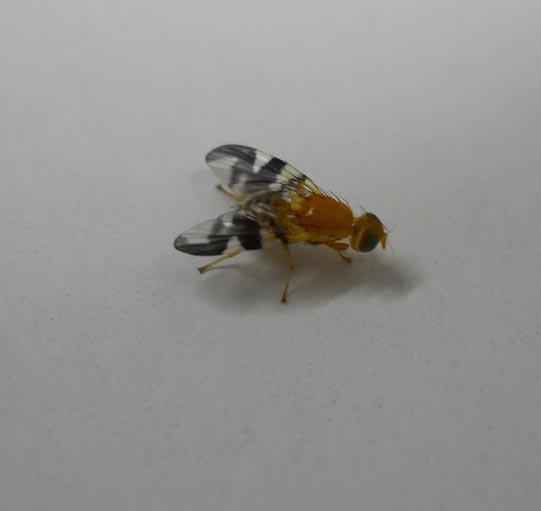
Green Spaces Don't Ensure Biodiversity in Urban Areas

Andrew Forbes lab, Univ. of Iowa
Green spaces in cities are great, but they don't ensure biodiversity, according to University of Iowa biologists. The team found insect abundance was lacking in two common urban trees, suggesting insect movement, such as the walnut fly, pictured above, may be limited by barriers, such as roads and buildings.
Planting trees and creating green space in cities is good for attracting species, but it may not be enough to ensure biodiversity in built environments, a University of Iowa study has found.
The researchers surveyed two types of tree in an urban area in Iowa, and recorded the abundance of two insects that interact with them. They found that while there were plenty of the trees, black cherry and black walnut, they didn’t find a corresponding abundance of the insects, in this case fruit flies that feed on the walnuts and black cherries and a type of wasp that feeds on the flies.
“In cities, you might have more trees, but you don’t necessarily have more insects associated with them,” says Andrew Forbes, associate professor of biology and an author on the paper, published online in the journal PLOS ONE. “There’s still this real impact on diversity that’s mediated by the landscape. This study implies that cities decrease diversity in some sort of fundamental, intrinsic way.”
Amanda Nelson, a graduate student in biology at the UI, led a team of a dozen UI undergraduates who surveyed 250 sites in Iowa City for black cherry and black walnut trees. At sites where the researchers found trees, they collected fruit and counted the fruit flies found in the walnuts and cherries. They also counted the parasitic wasps that feed on the flies at each site. Although the cherry and walnut trees were more common in urban sites, Nelson and her team found fewer flies and wasps in these locations than in agricultural or undeveloped sites.
The researchers believe that barriers found in urban landscapes, such as built structures and paved areas, may make it difficult, if not impossible, for the insects to reach other trees, mate with other populations and thus enrich the gene pool. Nelson is trying to determine which physical barriers have the greatest impact on the insects by currently comparing the DNA of flies across urban sites.
“We can model how they’re moving across the landscape and then compare that to the characteristics of landscapes that we think might be impeding them,” says Nelson, who earned undergraduate degrees in biology and environmental science at the UI and is the corresponding author on the paper.
While other studies have examined the density of a single insect species across a range of landscapes, no other study has examined insect interactions across such a broad area, says Forbes. Nelson and her team sampled tens of thousands of fruits and counted hundreds of thousands of insects during the survey, which lasted from 2011 to 2013.
“Planting a tree in the city is not sufficient to then have walnut flies and the wasps that attack those walnut flies,” says Forbes, who advised Nelson on the project. “We think there’s something about the city that changes those dynamics, those interactions between plants and flies and the insects that eat those flies.”
Despite this, Nelson thinks that finding ways for insects and people to share developed space is still an important goal to pursue.
“The responses of the diversity of organisms that could potentially share these developed areas with us can be really idiosyncratic. To promote the full diversity, we really have a lot to learn,” says Nelson, who’s from Exira, Iowa. “That doesn’t mean our efforts are wasted, but it definitely means that we need to continue trying to learn to do a better job and be thoughtful about it.”
The UI's Center for Global and Regional Environmental Research funded the work.
Contact Information
Richard Lewis
Director, Research News
richard-c-lewis@uiowa.edu
Phone: 319-384-0012
Mobile: 401-662-6336
Twitter: @UIowaResearch












